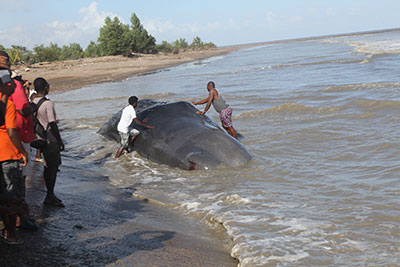
No not Priya 
Replies sorted oldest to newest
Former Member
Weighing 30 tons… 45-ft sperm whale washes up on Kitty foreshore – causing day-long traffic jam on Rupert Craig Highway
By Leroy Smith, December 16, 2014, Source - Guyana Chronicle

A man peels off skin from the dead whale as it lay sunk in the sand on the seashore (Photo by Sonell Nelson)
A SIX-year-old male sperm whale measuring 45 feet and weighing approximately 30 tons was discovered dead at about 05.30 hrs yesterday after it washed ashore at the Kitty seawall.
The whale was first spotted on Sunday in the Mahaicony area,where it was caught in the net of a fisherman who immediately reported the sighting to the relevant authorities after his efforts to free the gigantic mammal proved futile.

Public Works Minister, Mr Robeson Benn and Agriculture Minister Dr. Leslie Ramsammy are being briefed
The Guyana Chronicle understands that the search for the whale, after it got entangled in the net and disappeared on Sunday, continued late Monday evening by the relevant agencies but to no avail.
WHALE IN DISTRESS
And even if it were spotted during the course of the search, no attempt could have been made to rescue it, as no one in Guyana is trained to rescue a whale in distress. According to Ms Annette Arjoon-Martins, who is conversant with such matters, whales in distress can be very violent and can kill humans in the process.
THOUSANDS FLOCK SEAWALL
For the entire day yesterday, thousands of persons flocked the seawall to get a glimpse of the mammal, and for many, it was a first.

The traffic at right was brought to a halt as the thousands at left lined the seawall to get a glimpse of the dead whale (Photos by Sonell Nelson)
The police struggled to maintain crowd control, given the enthusiasm of the onlookers, including senior public officials and law enforcement officers.
The discovery of the whale also brought traffic to a halt at intervals, as motorists and passengers alike exited vehicles to catch a glimpse of the giant creature.
EDUCATIONAL PURPOSES
Late yesterday evening, the agencies were seeking to have the whale brought over the seawall so as to place it on a low-bed trailer and take it to the Linden-Soesdyke Highway. The plan is to bury it there and subsequently retrieve its skeleton for educational purposes by placing it in a museum.
Meanwhile, Romaine De Freitas of the Marine Turtle Conservation Society told reporters that it was important to have the whale buried in the white sand area, since most of its body is made up of fat; and should there be any attempt to bury it anywhere else, it would emit a big stench for as long as two months.
In addition, the fat and oil from the animal also has the potential to seep into waterways, leaving that unbearable stench for an even longer period.
PHOTO OPS
Yesterday, the thousands who turned out to view the dead whale were seen taking photographs, video footage and some even ventured into the Atlantic Ocean and touched the mammal, while yet others were seen mounting themselves on it to take plunges into the incoming waves.
During the search for the whale on Sunday and Monday, local personnel were receiving updates from experts in other parts of the world on an hourly basis on how to treat with the situation.
Had the whale been spotted alive, this newspaper understands, experts either from Venezuela or another country would have travelled here to assist in freeing it from the net in which it was ensnared.

Commander John Flores of the GDF Coast Guard briefs the media on efforts to locate the whale after it was first spotted on Sunday
When the animal was found on the foreshore yesterday,it had bits and pieces of the net inside its mouth.
Media representatives were told that whales generally beach themselves (travel to the seashore) whenever they are about to die as part of their culture in an effort not to pollute the water. It was suggested that the young whale might have been heading westward along the ocean off the Mahaicony shore to beach itself, when it came into contact with the fisherman’s net.
Last evening, excavators which were taken to the seashore to remove the whale to the low-bed trailer met with quite a challenge, even as spectators suggested the use of a crane to remove the huge mammal.
GENUS
According to Wikipedia, the sperm whale (Physeter macrocephalus), or cachalot, is the largest of the toothed whales and the largest toothed predator. It is the only living member of genus, Physeter, and one of three extant species in the sperm whale family, along with the pygmy sperm whale and dwarf sperm whale of the genus Kogia.

Romaine De Freitas of the Turtle Conservation Society speaks of the importance of disposing of the whale away from areas which are densely populated
Mature males average 16 metres (52 ft) in length, but some may reach 20.5 metres (67 ft), with the head representing up to one-third of the animal’s length. The sperm whale feeds primarily on squid. Plunging to 2,250 metres (7,380 ft) for prey, it is the second deepest diving mammal, following only the Cuvier’s beaked whale. The sperm whale’s clicking vocalization, a form of echolocation and communication, may be as loud as 230 decibels underwater, making it the loudest sound produced by any animal. It has the largest brain of any animal on Earth, more than five times heavier than a human’s. And sperm whales can live for more than 60 years.”
The sperm whale can be found anywhere in the open ocean. Females and young males live together in groups while mature males live solitary lives outside of the mating season. The females cooperate to protect and nurse their young. Females give birth every four to twenty years, and care for the calves for more than a decade. A mature sperm whale has few natural predators. Calves and weakened adults are taken by pods of orcas.
WHALING
From the early 18th Century through the late 20th Century, the species was a prime target of whalers. The head of the whale contains a liquid wax called spermaceti, from which the whale derives its name.
Spermaceti was used in lubricants, oil lamps, and candles. Ambergris, a waste product from its digestive system, is still used as a fixative in perfumes. Occasionally the sperm whale’s great size allowed it to defend itself effectively against whalers. The species is now protected by a whaling moratorium, and is currently listed as vulnerable by the IUCN.”
(By Leroy Smith)
Source - http://guyanachronicle.com/wei...upert-craig-highway/
Add Reply
Sign In To Reply
150 online (1 member
/
149 guests)


